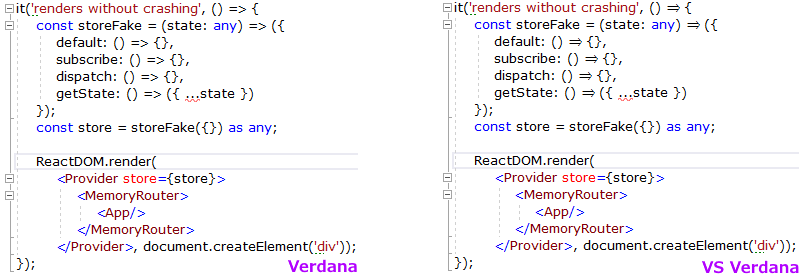Verdana tweaked for Programming
Verdana is the perfect programming font... but the latest Visual Studio releases do some per-symbol layout malarkey which ruins the angle bracket kerning. I guess nobody at Microsoft uses proportional fonts anymore.
So I've created a tweaked font (in FontForge) which abuses the glyph hinting so that everything looks nice again in Visual Studio.
I also added a => ligature, and widened the hyphen.

FontForge needs to run the script which generates the new font:
shell
$ fontforge -script vsVerdana.pyWhere vsVerdana.py is:
python
import fontforge
import sys
def unmapGlyph(font, glyphname):
glyph = font[glyphname]
glyph.unicode = -1
glyph.glyphname = ".unmapped" + glyph.glyphname
def modifyFont(font):
# remap hyphen (short & fat) to figuredash (long and skinny)
unmapGlyph(font, "hyphen")
figuredash = font["figuredash"]
figuredash.altuni = (0x2D,)
# nice looking => glyph
goesTo = font.createChar(-1, ".unmappedgoesto")
goesTo.width = 2412
goesToContour = fontforge.contour()
goesToContour.is_quadratic = True
goesToContour.moveTo(2182, 672)
goesToContour.lineTo(1660, 21)
goesToContour.lineTo(1578, 86)
goesToContour.lineTo(1826, 362)
goesToContour.lineTo(230, 362)
goesToContour.lineTo(230, 522)
goesToContour.lineTo(1938, 522)
goesToContour.lineTo(2056, 672)
goesToContour.lineTo(1959, 782)
goesToContour.lineTo(230, 782)
goesToContour.lineTo(230, 942)
goesToContour.lineTo(1825, 942)
goesToContour.lineTo(1586, 1195)
goesToContour.lineTo(1664, 1265)
goesToContour.closed = True
goesToLayer = fontforge.layer()
goesToLayer.is_quadratic = True
goesToLayer += goesToContour
goesTo.foreground = goesToLayer
goesTo.ttinstrs = fontforge.parseTTInstrs("""NPUSHB\n32\n4\n84\n5\n9\n84\n5\n15\n10\n1\n10\n64\n15\n1\n48\n15\n64\n15\n2\n3\n4\n9\n47\n8\n64\n8\n2\n8\n8\n64\n9\n1\n9\nMDAP[rnd]\nDELTAP1\nSHP[rp1]\nMDAP[rnd]\nDELTAP1\nSRP2\nIP\nIP\nDELTAP1\nDELTAP1\nSVTCA[y-axis]\nMDAP[rnd]\nDELTAP1\nSHP[rp1]\nMIRP[min,rnd,black]\nMDAP[rnd]\nMIRP[min,rnd,black]\nIUP[x]\nIUP[y]""")
font["less"].ttinstrs = fontforge.parseTTInstrs("""PUSHB_5\n 115\n 5\n 1\n 44\n 0\nPUSHW_1\n -30\nNPUSHB\n 31\n 10\n 24\n 55\n 3\n 30\n 10\n 24\n 55\n 3\n 31\n 0\n 47\n 0\n 2\n 3\n 15\n 0\n 1\n 0\n 8\n 4\n 5\n 1\n 0\n 0\n 64\n 1\n 80\n 1\n 2\n 1\nMDAP[rnd]\nDELTAP1\nSHP[rp1]\nMDAP[rnd]\nSRP2\nIP\nIP\nSHP[rp1]\nSVTCA[y-axis]\nMDAP[rnd]\nDELTAP1\nSHP[rp1]\nDELTAP1\nMDAP[rnd]\nCALL\nCALL\nIUP[x]\nIUP[y]\nMPPEM\nGTEQ\nIF\nNPUSHB\n 11\n 5\n 4\n 84\n 3\n 2\n 3\n 6\n 84\n 0\n 1\n 0\nSDPVTL[orthog]\nSRP0\nMIRP[rp0,min,rnd,black]\nSDPVTL[orthog]\nSRP0\nMIRP[rp0,min,rnd,black]\nSFVTCA[x-axis]\nMDRP[grey]\nEIF\nSVTCA[x-axis]\nDELTAP1""")
font["greater"].ttinstrs = fontforge.parseTTInstrs("""PUSHB_5\n 124\n 3\n 1\n 44\n 1\nPUSHW_1\n -30\nNPUSHB\n 33\n 10\n 24\n 55\n 5\n 30\n 10\n 24\n 55\n 5\n 31\n 1\n 47\n 1\n 2\n 5\n 15\n 1\n 1\n 1\n 8\n 3\n 5\n 1\n 0\n 0\n 47\n 1\n 48\n 1\n 64\n 1\n 3\n 1\nMDAP[rnd]\nDELTAP1\nSHP[rp1]\nMDAP[rnd]\nSRP2\nIP\nIP\nSHP[rp1]\nSVTCA[y-axis]\nMDAP[rnd]\nDELTAP1\nSHP[rp1]\nDELTAP1\nMDAP[rnd]\nCALL\nCALL\nIUP[x]\nIUP[y]\nMPPEM\nGTEQ\nIF\nNPUSHB\n 11\n 3\n 4\n 84\n 5\n 5\n 6\n 2\n 84\n 1\n 1\n 0\nSDPVTL[orthog]\nSRP0\nMIRP[rp0,min,rnd,black]\nSDPVTL[orthog]\nSRP0\nMIRP[rp0,min,rnd,black]\nSFVTCA[x-axis]\nMDRP[grey]\nEIF\nSVTCA[x-axis]\nDELTAP1""")
# ligature so our nice looking => glyph gets used
font.addLookup("ligavs", "gsub_ligature", (),
(("liga", (("latn", ("dflt")),)),))
font.addLookupSubtable("ligavs", "ligavs")
goesTo.addPosSub("ligavs", ("equal", "greater"))
# kern pairs for << >> ||
font.addLookup("kernvs", "gpos_pair", (),
(("kern", (("latn", ("dflt")),)),))
font.addLookupSubtable("kernvs", "kernvs")
font["less"].addPosSub("kernvs", "less", -268)
font["greater"].addPosSub("kernvs", "greater", -268)
font["bar"].addPosSub("kernvs", "bar", -302)
# reencode so our new chars get used
font.reencode("unicode")
def nameFont(font, fontFamily, fontWeight):
font.familyname = fontFamily
fontIsBold = "Bold" in fontWeight
fontIsItalic = "Ital" in fontWeight
font.weight = "Bold" if fontIsBold else "Book"
fontNeedsSuffix = (fontIsBold or fontIsItalic)
font.fontname = font.familyname.replace(
" ", "") + (("-" + fontWeight.replace(" ", "")) if fontNeedsSuffix else "")
font.fullname = font.familyname + \
((" " + fontWeight) if fontNeedsSuffix else "")
font.uniqueid = 0
font.sfnt_names = ((0x409, 1, font.familyname),
(0x409, 2, fontWeight), (0x409, 4, font.fullname))
font.os2_weight = 700 if fontIsBold else 400
font.macstyle = (0x01 if fontIsBold else 0x00) | (
0x02 if fontIsItalic else 0x00)
panose = list(font.os2_panose)
if (panose[2] <= 0x06 and fontIsBold):
panose[2] = 0x08
if (panose[2] > 0x06 and not fontIsBold):
panose[2] = 0x06
if (panose[7] >= 0x02 and panose[7] <= 0x08 and fontIsItalic):
panose[7] += 0x07
if (panose[7] >= 0x09 and panose[7] <= 0x0F and not fontIsItalic):
panose[7] -= 0x07
font.os2_panose = tuple(panose)
def main(argv):
font = fontforge.open("C:\\Windows\\Fonts\\verdana.ttf")
modifyFont(font)
nameFont(font, "Vs Verdana", "Regular")
font.generate(font.fontname + ".ttf")
font.close()
if __name__ == '__main__':
main(sys.argv[1:])